
Like many Americans, I’ll never forget, not just the horror of watching hijacked airplanes fly straight into the World Trade Center’s Twin Towers in New York on the crystal-clear morning of September 11th, 2001, but also the immediate, defiant determination of the people of New York to rebuild the towers as quickly as humanly possible as a memorial to those who died there.
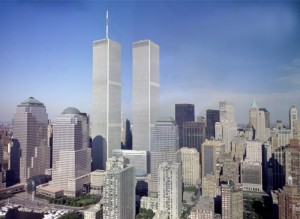
This photo, like all by Carol in today's posting, was taken, by happenstance, about a month before the Twin Towers fell. (Carol M. Highsmith)
While it became abundantly clear that the towers had become hated icons of American capitalism among our nation’s hidden enemies in the years prior to the attack — and thus both a symbolic and terribly real target — they had also become a growing, if grudging, source of pride for New Yorkers.
As the countdown begins to the 10th anniversary of the attacks upon the Twin Towers and the Pentagon in Washington, as well as the crash in Pennsylvania of a plane that passengers tried and failed to take back from terrorist hijackers, you’ll soon be reliving those days and their aftermath.
Here, though, I’d like to go back to the time when the towers stood haughtily over the Lower Manhattan skyline, eclipsing any other structure on earth, including New York’s own longtime symbol of height and might and wealth: the Empire State Building.
There is no doubt that the Trade Center’s twin 110-story towers came to symbolize U.S. economic suzerainty, or that Americans as well as television viewers worldwide would be stunned to see them missing, like two front teeth knocked out, from the New York skyline.
Yet like an amputee’s phantom limbs, to use another physical simile, the soaring towers still throb in America’s memory. Nobody had ever built such a city within a cluster of seven buildings, including the two giant towers. Fifty thousand people — about the same number as live in entire American cities such as Pine Bluff, Arkansas, toiled inside them for 430 banks, securities firms, law offices, shippers, engineering groups, stockbrokerages, and insurance companies. Delicatessens and doughnut shops and shoeshine stands, too.
All told, the buildings were said to contain 10 percent of all the office space in Manhattan. If you’ve seen the canyons of skyscrapers on that island, you can appreciate the enormity of that figure.
In 1999, Angus Kress Gillespie, a Rutgers University professor of American studies, wrote a book about the World Trade Center. A modest 3,000 copies were printed, but only 2,000 had sold as of September 11th, 2001.
A week or two later, after the terrorist assaults from the air, the books could not be printed fast enough, and the obscure book became a best-seller.
Why? Interest in the people killed, the rescue workers, and the long-term significance of the tragedy is understandable. But why the visceral fascination with the skyscrapers themselves?
“In the book, I argue that just as Big Ben represents London and England, and just as the Eiffel Tower represents Paris and France, so the Twin Towers represented America,” Gillespie told me at the time. “They’re in close proximity to Wall Street, so by extension they represented American capitalism, and consequently, the entire American way of life.”
When the first of the Twin Towers was completed in 1972, it usurped New York’s beloved, art deco Empire State Building as the world’s tallest structure. Sears Tower in Chicago soon took the title, but the World Trade Center towers continued to awe people because of their sheer volume, not just their height.
If you took the entire square footage of the Empire State Building — all 102 stories of it — it would not have filled the sub-basements of the two Twin Towers! Each floor of one World Trade Center tower was about an acre — four-tenths of a hectare — in size. We think of the towers as looming aluminum and glass stalks into the sky, but they were also close to being cities unto themselves.
Still, skeptical New Yorkers, who generally brag on their city as the biggest and the best, were slow to warm to their new twin peaks. Architectural scolds said they were too big, too boxy, an imposition on the skyline, too far from the action in Midtown, and disrespectful of the revered Empire State Building.
Conservationists were appalled when they realized the buildings at first had no light switches, and thousands and thousands of the trade center’s offices glowed all night long. And animal lovers were aghast because migrating birds kept bashing into the towers.
But visitors adored them, cherished the view from their observation deck, loved the Windows on the World restaurant on the 106th floor, thrilled to the express elevator rides to so-called “sky lobbies” on the 44th and 78th floors. They loved to snap photos of the sun, and even moonlight, on the shiny towers at various times of day. Angus Gillespie told me even workaholics who labored in the buildings found serenity, high in these twin aeries.
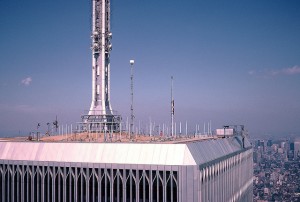
Looking at the North Tower's roof, with other Manhattan skyscrapers looking minuscule in the distance. (bill85704, Flickr Creative Commons)
As you stood on the 110th floor of either building, and you looked down, you could see the hustle and bustle of the taxicabs and the buses, darting in and out. But you couldn’t hear a thing because they were so far away. It was like floating in a cloud, high above all the noise and confusion at street level.
The World Trade Center was the brainchild of billionaire David Rockefeller, who had put a resplendent bank building in Lower Manhattan and wanted something grand to go with it — something to dress up a financial district filled with decaying old buildings.
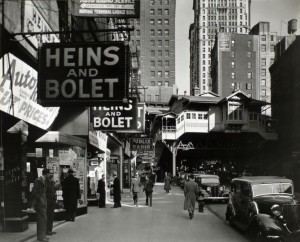
With the help of his brother, New York governor Nelson Rockefeller, David Rockefeller and others saw to it that the Port Authority of New York and New Jersey got control of the land. This public agency would fulfill the Rockefellers’ grand vision.
In the months after another band of terrorists detonated bombs in the center’s basement one snowy February morning in 1993, killing six people and injuring a thousand more, New Yorkers took a fresh look at the Twin Towers and decided they liked them after all.
Eric Darton, a lecturer at New York University, who also wrote a book about the World Trade Center, told me the idea that the Twin Towers somehow represented the resilience of Americans after that first attack was multiplied after the ruinous and murderous assaults eight years later.
I had no idea until the towers fell that so many people — so many people around the world — had invested so much, psychologically, in these emblems. And had to really feel our way through the next year — feel what it was like to be in this new world where two immense symbols of domination can simply crumble. This horrific situation provided us with an opportunity to really reflect on our culture, and on our culture of cities in particular.
Early the very year that the towers fell, New York developer Larry Silverstein paid more than $3 billion for a 99-year lease on the World Trade Center. It was the most money ever spent on a piece of New York City property.
After the terrorist onslaught of September 11th, Silverstein and New York’s U.S. senators met and committed to rebuild the towers as a memorial to the victims, and as a statement of defiance to terrorism.
Eric Darton told me he understood this figurative shaking of a fist at our enemies. He said he ran into people who carried his book around for some kind of comfort.
In some cases, people holding it in their hand is the closest thing to a material piece of the World Trade Center. And that’s something that came home to me profoundly a couple of days ago when somebody actually handed me a copy of the book to sign. And I hadn’t in a way even been thinking of myself as the author of the book. I had simply been thinking of myself as a storyteller. I really believe that a time when people and structures are being torn apart, it is narratives and stories that hold us together.

The same sort of outpouring of grief mixed with appreciation and determination materialized in a Pennsylvania field near the spot where the terrorist-hijacked United Flight 93 crashed on 9/11. (Carol M. Highsmith)
That feeling persists a decade later. Just this week, the coach of one of New York’s professional football teams, the Jets, took his entire team to the World Trade Center site following a season-kickoff luncheon at a Wall Street restaurant. “A very humbling experience,” defensive player Antonio Cromartie wrote on his Twitter page. “A really heartfelt experience. God Bless everyone.”
The team spoke with construction workers who are erecting steel columns and the core concrete of a $3.1-billion 1 World Trade Center replacement building, which for a time was simply called “Freedom Tower.”
It will soar 1,776 feet [541 meters] into the air above Battery Park at the southern tip of Manhattan. That number of feet is not arbitrary. The year 1776 is treasured as the year of our nation’s independence.
1 World Trade Center will include an illuminated mast that evokes the look of the Statue of Liberty’s torch, which itself rises not far away in New York Harbor. But the bulk of the building — which will taper into eight tall isosceles triangles, forming an octagon at its center — will be set farther away from Wall Street, to minimize the chance that it could be the target of future attacks from the air.
There’ll be an observation deck 105 stories above the ground, and a square, glass parapet at 1,368 feet [417 meters], the exact height of the original Twin Towers. More symbolism, by design.
From there, an illuminated spire containing a television antenna will rise to the 1,776-foot summit.

When it's finished two years hence, a World Trade Center tower will again be America's tallest building. (Wikipedia Commons)
The new building, which is projected to open about two years from right now, will include 242,000 square meters of office space, fine restaurants, below-ground retail stores — and access to New York’s subway; Port Authority commuter trains to New Jersey across the Hudson River; and a connection to the four lower towers of the nearby World Financial Center that overlook the Hudson.
Like many other Americans, Carol and I have deliberately traveled to New York — at least once a year in our case — and stayed at the Hilton Millennium Hotel. It’s a lovely place, but that’s not why we choose it.
The Millennium overlooks the World Trade Center site, and we specify a room facing in that direction, just so we can keep a sort of private, if occasional, vigil, get a visual progress report, and pay a moment of defiant homage all our own.
Toward twilight, the World Trade Center’s Twin Towers shimmered. At night, as one writer described it, they shone like pearls. One day out that hotel window, we hope to see something close to that again.

A brighter day, ten years ago. (Carol M. Highsmith)
Ted's Wild Words
These are a few words from this posting that you may not know. Each time, I'll tell you a little about them and also place them into a cumulative archive of "Ted's Wild Words" in the right-hand column of the home page. Just click on it there, and if there's another word that you'd like me to explain, just ask!
Isosceles triangle. A triangle with two equal sides and one of a different length.
Suzerainty. Dominion by one entity — often a nation — over another.
Visceral. A word used to describe deep, almost physical rather than intellectual, feelings or reactions. As it’s sometimes put, it describes a “gut feeling.”

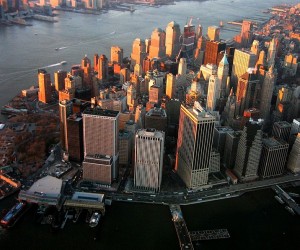
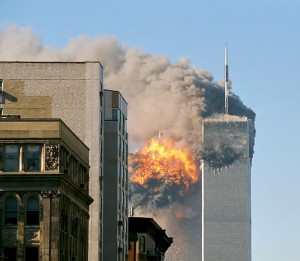
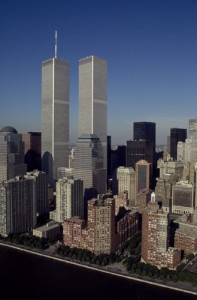
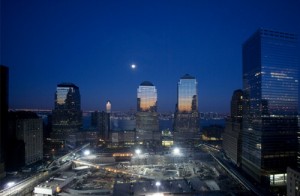

12 responses to “Remembering the Twin Towers”
I am sorry for all the casualties who were directly or indirectly involve in this tragedy. We only know about bits and pieces of the conspiracy that led to this and also what follows after this. There are many people who talk about it. There are many questions answered and unanswered. We talk about peace. But at the end of the day it is we ourselves who will determine whether there is peace or war by encouraging or discouraging it.
Godbless America!
Controlled Demolition all the way and people continue to deny that there is a cover up. I was young when it happened and fed into all the propaganda but it was always wierd to me how they fell so so so so perfectly!!! And it was always wierd to me that there were so so so so many accounts of explosions on the lower floors!!! And lastly it was wierd to me that the steel was driven the the hell out of the city so so so so fast during the cleanup!!!
Also, by 9:34 AM EST that morning the news was already blaming Bin Laden and talking about his Caves and Huts in Afghanistan instead of being in shock and awe at the horrific event which just took place!!!
Conspiracy theorist, 10 years later.
Ted
It was a typical provocation.
At one time, the Nazis burned the Reichstag.
Boys from the Bush administration decided to demolish the towers …
A very convenient excuse for war …Iraq, Afghanistan……
Only naive people believe in conspiracy theories of bearded Arabs.
A State Department official propagandists pretend to believe in it …
It’s this kind of blame America first regardless supidity that will bring more of the same. I guess it’s easier than facing the truth about those who did it and what that means for our future. We didn’t really go to the moon either, I suppose.
Especially wildly all the accusations against Al-Qaeda look after the American planes support the terrorists of Al Qaeda in their rebellion against Gadhafi and the Libyan people.
Message from Aisha Qadafi, September 3, 2011:
http://www.mathaba.net/news/?x=628548%3Frss
“Even if my father and my brothers are martyred, I will continue my fight against Islamic terrorists in Libya.
Soon, I will appear in the media to announce the fight against terrorists and Al-Qaeda in Libya and other countries in the world.
Let the West and their mercenaries take note; Aisha Qadhafi will never surrender to their conspiracy of evil.
I carry the blood of a heroic father in my veins and I have never known the idea of surrender.
NATO and Western assassins killed my husband and my child. But they must know by now that Aisha Qadhafi is a soldier.
Even at the cost of my own life, I will free my country from the clutches of Islamic terrorists and Al Qaeda.”
So the U.S. war on the side of the organizers of 11/09/2001 !!!!!!
Have you actually read or heard anything from those who question what you assume as the truth because the government (your employer) told you so, Ted?
Many of them are professionals who say there is just no way that science can justify the accepted 9-11 chronology. It’s not just wackos who don’t trust the official version of the “investigation.” There are too many inexpicable coincidences. http://www.ae911truth.org/
Dear Jonny,
The big, bad government is indeed my employer, but it doesn’t tell me what to say or not say, publish or not publish, or believe or not believe.
Send me a list of the “inexplicable coincidences” about 9/11, and assuming they’re not libelous or profane, I’ll publish them and let my readers judge for themselves.
Ted
In my first comment, I sent you a link to the site where (so far) 1,575 professional architects and engineers are calling for a real investigation into the collapse of the twin towers and building 7. Besides questions about the fact that WTC Building #7, a 47-story high-rise which was not touched by an airplane or other exterior damage, collapsed and exhibited all the characteristics of classic controlled demolition with explosives, there is also the obvious fact that never before in human history has a high-rise building ever collapsed, even when much larger, hotter, and longer fires have been involved. The main site, again, is here: http://www.ae911truth.org/
There is a particularly strong evidence that merits questions and consideration here: http://issuu.com/larrylandon/docs/directly?mode=embed&layout=http://skin.issuu.com/v/color/layout.xml&backgroundColor=2a2c6c and here: http://www2.ae911truth.org/downloads/NIST_Analyses_Brookman.pdf
That should be “Never in human history has a steel-framed high rise building ever collapsed due to fire.”